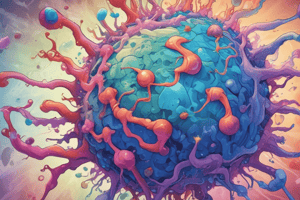Podcast
Questions and Answers
What maintains the electrons in their orbits around the nucleus?
What maintains the electrons in their orbits around the nucleus?
- Electromagnetic force and weak nuclear force
- Strong nuclear force and weak nuclear force
- Electrostatic force and centrifugal force (correct)
- Gravitational force and electromagnetic force
Why is an atom neutral?
Why is an atom neutral?
- It has an equal number of negative charges (electrons) and positive charges (protons) (correct)
- It has more electrons than protons
- It has more protons than electrons
- It has an equal number of negative charges (electrons) and neutral charges (neutrons)
What is the atomic weight or mass number of an atom?
What is the atomic weight or mass number of an atom?
- The number of protons inside the nucleus
- The number of electrons outside the nucleus
- The number of protons and neutrons in the nucleus (correct)
- The number of neutrons in the shell
What causes the electrons to be pulled toward the protons in the nucleus?
What causes the electrons to be pulled toward the protons in the nucleus?
What is the atomic number of an atom?
What is the atomic number of an atom?
What is the normal range for platelet count in the blood?
What is the normal range for platelet count in the blood?
What is the origin of platelets?
What is the origin of platelets?
What is the primary cause of immediate vasoconstriction of injured blood vessels?
What is the primary cause of immediate vasoconstriction of injured blood vessels?
What is the first step in platelet plug formation?
What is the first step in platelet plug formation?
Study Notes
Atomic Structure
- The electrically charged protons in the nucleus attract electrons, maintaining them in their orbits around the nucleus.
- An atom is neutral because it has an equal number of positively charged protons and negatively charged electrons.
Atomic Number and Mass
- The atomic number of an atom is the number of protons in the nucleus.
- The atomic weight or mass number of an atom is the total number of protons and neutrons in the nucleus.
Platelets
- The normal range for platelet count in the blood is 150,000 to 450,000 platelets per microliter.
- Platelets originate from megakaryocytes in the bone marrow.
- The primary cause of immediate vasoconstriction of injured blood vessels is the release of thromboxane A2 and endothelin-1, which are potent vasoconstrictors.
- The first step in platelet plug formation is the adhesion of platelets to the injured blood vessel wall, facilitated by von Willebrand factor.
Studying That Suits You
Use AI to generate personalized quizzes and flashcards to suit your learning preferences.
Description
Test your knowledge of X-ray and radiation protection with this physics quiz. Explore topics such as ionization processes, ionizing vs non-ionizing radiation, the use of X-rays as a diagnostic tool, and the structure of the atom. Challenge yourself with questions about the direct and indirect action of radiation and the radio-sensitivity of cells.




